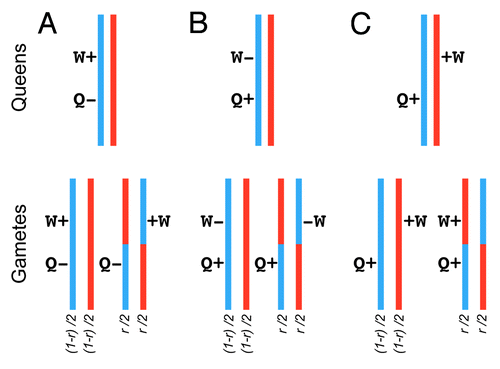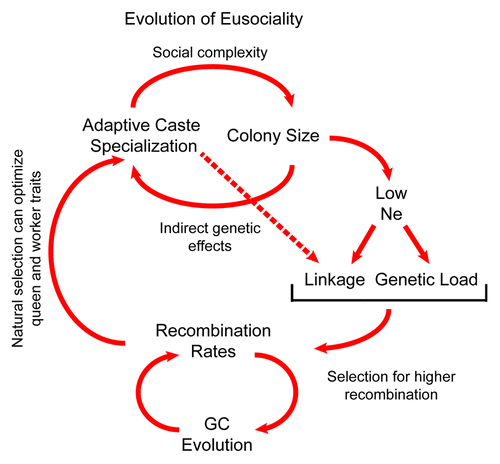Figures & data
Figure 1. Recombination and the evolution of caste specialization. Recombination can enhance concurrent selection on initially linked mutations that influence queen and worker traits. We assume that both mutations are recent (i.e., have low frequency). We depict frequencies of the different gametes assuming a recombination rate r, which ranges between 0 to 50% (i.e., free recombination). (A) A haplotype containing a slightly deleterious mutation affecting queens linked to a beneficial mutation affecting worker traits and enhancing colony fitness. Recombination can generate a haplotype containing the beneficial worker mutation and the wild-type queen allele, thereby facilitating both positive selection (on the ‘worker’ mutation) and purifying selection (on the ‘queen’ mutation). (B). A haplotype containing a beneficial mutation affecting a queen trait linked to a slightly deleterious mutation affecting a worker trait. Recombination can facilitate concurrent positive selection (on the ‘queen’ mutation) and purifying selection (on the ‘worker’ mutation). (C) Two haplotypes, each containing a beneficial mutation affecting a queen, and a worker trait respectively. These two mutations are on different haplotypes but are spatially proximate. Without recombination, selection will fix one haplotype at the expense of the other. However, one of the recombinant gametes will contain both beneficial mutations allowing for concurrent positive selection on queen and worker traits.

Figure 2. Conceptual model for the evolution of eusociality and recombination rates. Increasing social organization and caste complexity lead to colonies with more workers per queen, reducing effective population size Ne. Lower Ne increases linkage disequilibrium and fixation of mildly deleterious mutations, especially in genomic regions with low recombination. This increases Hill-Robertson interference that can in turn select for higher R, which allows natural selection to act more efficiently on mutations affecting worker traits such as behavior. This in turn facilitates the evolution of higher social complexity and colony sizes that further depress Ne.
